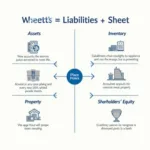Incomplete Sentences (Part 1)
Let’s begin with 30 practice questions for the Incomplete Sentences section of the TOEIC Reading test, focusing on vocabulary and grammar related to business loan applications.
-
The bank requires a detailed _____ plan before considering any loan application.
A. business
B. busy
C. businessman
D. businesslike -
Financial statements must be _____ by a certified public accountant before submission.
A. audited
B. audienced
C. audio
D. audible -
The loan officer will _____ the applicant’s credit history thoroughly.
A. review
B. revise
C. revive
D. revolt -
A strong cash flow projection is _____ to demonstrating the ability to repay the loan.
A. crucial
B. critical
C. crucial
D. cryptic -
The collateral offered must be of sufficient value to _____ the loan amount.
A. secure
B. ensure
C. insure
D. assure -
The interest rate on the loan will be _____ based on the applicant’s creditworthiness.
A. determined
B. detained
C. detached
D. detained -
Small businesses often struggle to meet the _____ requirements set by traditional banks.
A. stringent
B. strident
C. stringy
D. strenuous -
A comprehensive business plan should include market analysis and financial _____.
A. projections
B. projectors
C. projects
D. projectiles -
The loan application form must be filled out _____ to avoid processing delays.
A. accurately
B. acutely
C. actually
D. actively -
Many entrepreneurs seek _____ capital to fund their startup ventures.
A. seed
B. feed
C. weed
D. deed -
The bank may require personal _____ from the business owners for certain types of loans.
A. guarantees
B. warranties
C. promises
D. assurances -
A good credit score can significantly _____ the chances of loan approval.
A. enhance
B. enlarge
C. enrage
D. engage -
The repayment terms of the loan are _____ in the contract agreement.
A. stipulated
B. stimulated
C. stipend
D. stifled -
Applicants must provide evidence of their ability to _____ existing debts.
A. service
B. serve
C. swerve
D. survey -
The loan officer will assess the business’s _____ to determine its ability to generate profit.
A. viability
B. visibility
C. vitality
D. vicinity -
A detailed inventory list may be required as part of the loan _____ process.
A. underwriting
B. undertaking
C. undermining
D. underlying -
The bank will consider the applicant’s _____ ratio when evaluating the loan request.
A. debt-to-income
B. profit-to-loss
C. asset-to-liability
D. risk-to-reward -
Some lenders offer _____ loans specifically tailored for small businesses.
A. microfinance
B. macrofinance
C. megafinance
D. minifinance -
The loan application must include a detailed _____ of how the funds will be used.
A. breakdown
B. breakthrough
C. breakup
D. breakout -
Successful applicants will receive a loan _____ letter outlining the terms and conditions.
A. approval
B. approbation
C. appropriation
D. appreciation -
The bank may require _____ financial statements for the past three years.
A. audited
B. augmented
C. automated
D. authenticated -
A solid business plan should demonstrate the company’s _____ advantage in the market.
A. competitive
B. completion
C. compliant
D. compulsive -
The loan officer will _____ the applicant’s industry experience and management skills.
A. evaluate
B. elevate
C. elaborate
D. eliminate -
Applicants must provide a clear _____ of their business structure and ownership.
A. outline
B. outlay
C. outlet
D. outlaw -
The interest rate on the loan may be fixed or _____ depending on the terms.
A. variable
B. varied
C. variance
D. various -
A strong cash flow statement is essential to demonstrate the ability to _____ the loan.
A. service
B. severe
C. sever
D. serve -
The bank will assess the _____ of the business before approving the loan application.
A. creditworthiness
B. credit score
C. credit card
D. credit limit -
Applicants should be prepared to provide _____ documentation to support their loan request.
A. extensive
B. expensive
C. expansive
D. expressive -
The loan agreement will specify the _____ schedule for repayment of the principal and interest.
A. amortization
B. ammunition
C. ambition
D. admission -
Successful loan applicants must adhere to the _____ outlined in the loan agreement.
A. covenants
B. conveniences
C. conventions
D. conveyances
Text Completion (Part 2)
Now, let’s practice the Text Completion section with four passages related to business loan applications, each containing four blanks to fill.
Passage 1
Small business owners often find the process of applying for a loan to be (1). To increase their chances of approval, applicants should ensure their business plan is (2) and includes detailed financial projections. It’s also crucial to have a clear (3) for the loan funds and to demonstrate the ability to (4) the loan according to the agreed terms.
- A. daunting B. exciting C. simple D. unnecessary
- A. vague B. brief C. comprehensive D. colorful
- A. disregard B. purpose C. aversion D. indifference
- A. repay B. ignore C. extend D. forfeit
Passage 2
When evaluating a loan application, banks consider several factors. The applicant’s (5) history plays a significant role in the decision-making process. Lenders also assess the business’s (6), examining its current financial statements and future projections. The (7) offered as security for the loan must be of sufficient value. Finally, the bank will review the business owner’s (8) and industry experience.
- A. credit B. criminal C. academic D. travel
- A. location B. size C. color D. viability
- A. collateral B. employees C. products D. services
- A. age B. height C. background D. hobbies
Passage 3
Preparing a loan application package requires attention to detail. Applicants should gather all necessary (9) before beginning the process. This typically includes tax returns, financial statements, and a detailed (10) plan. It’s important to be (11) when filling out the application form, as errors can lead to delays or rejection. Many banks offer (12) sessions to help applicants understand the requirements and improve their chances of success.
- A. equipment B. furniture C. documentation D. decoration
- A. evacuation B. business C. diet D. exercise
- A. careless B. thoughtful C. hasty D. meticulous
- A. counseling B. exercise C. cooking D. cleaning
Passage 4
The terms and conditions of a business loan are crucial aspects that applicants must carefully consider. The (13) rate, whether fixed or variable, significantly impacts the total cost of borrowing. The loan’s (14) period determines the monthly payment amount and the overall interest paid. Some loans may include a (15) payment at the end of the term. It’s essential for borrowers to fully understand their (16) under the loan agreement before signing.
- A. exchange B. interest C. discount D. markup
- A. repayment B. vacation C. storage D. shipping
- A. bonus B. penalty C. balloon D. discount
- A. privileges B. exemptions C. obligations D. hobbies
Answer Key
Incomplete Sentences (Part 1)
- A
- A
- A
- B
- A
- A
- A
- A
- A
- A
- A
- A
- A
- A
- A
- A
- A
- A
- A
- A
- A
- A
- A
- A
- A
- A
- A
- A
- A
- A
Text Completion (Part 2)
Passage 1:
- A
- C
- B
- A
Passage 2:
5. A
6. D
7. A
8. C
Passage 3:
9. C
10. B
11. D
12. A
Passage 4:
13. B
14. A
15. C
16. C
This comprehensive practice set focuses on vocabulary and concepts related to business loan applications, helping test-takers familiarize themselves with the language and structure typically encountered in TOEIC Reading Part 1 and Part 2 questions. By working through these exercises, students can improve their understanding of business finance terminology and enhance their overall performance on the TOEIC Reading test.




